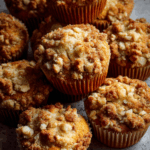Saffron Rice Kheer is a traditional Indian dessert celebrated for its creamy texture and aromatic flavors. This luscious pudding combines slow-cooked rice with rich milk, infused with the luxurious essence of saffron and cardamom. Often served during festivals and special occasions, saffron rice kheer is cherished for its delicate sweetness and warm, inviting aroma.
FULL RECIPE
Ingredients
- ½ cup basmati rice
- 1 liter full-fat milk
- ¾ cup sugar
- A pinch of saffron strands
- 2 tablespoons warm milk (for soaking saffron)
- ½ teaspoon cardamom powder
- 2 tablespoons chopped almonds
- 2 tablespoons chopped pistachios
- 1 tablespoon raisins (optional)
- 1 tablespoon ghee
Directions
- Rinse the basmati rice thoroughly under running water until the water runs clear. Soak the rice for 30 minutes, then drain.
- Soak saffron strands in 2 tablespoons of warm milk and set aside to release color and aroma.
- Heat ghee in a heavy-bottomed pan over medium heat. Add the drained rice and sauté gently for 2-3 minutes until slightly fragrant.
- Pour in the milk and bring it to a gentle boil. Reduce the heat to low and simmer, stirring occasionally to prevent sticking.
- Cook the rice in milk for about 45-50 minutes or until it becomes soft and the mixture thickens to a creamy consistency.
- Add sugar and continue to cook, stirring well, until the sugar dissolves completely.
- Stir in the saffron-infused milk and cardamom powder. Mix well and cook for another 5 minutes.
- Add chopped almonds, pistachios, and raisins (if using). Cook for an additional 2 minutes.
- Remove from heat and let the kheer cool slightly before serving. It can be enjoyed warm or chilled.
Nutrition Facts
- Calories: 250 kcal
- Total Fat: 8g
- Saturated Fat: 5g
- Cholesterol: 25mg
- Sodium: 40mg
- Total Carbohydrates: 38g
- Dietary Fiber: 1g
- Sugars: 28g
- Protein: 6g
- Calcium: 220mg
- Iron: 0.8mg
Cultural Significance of Saffron Rice Kheer
Saffron Rice Kheer holds a treasured spot in Indian culinary traditions, especially during festivals such as Diwali, Eid, and weddings. This dessert symbolizes purity and prosperity, often offered as prasad in temples and served to guests during celebratory meals. The use of saffron, one of the most precious spices, elevates the dish to a festive status, making it a popular choice for joyous occasions.
Nutritional Benefits of Ingredients
The core ingredients of saffron rice kheer—rice, milk, and nuts—contribute to its wholesome nutrition profile. Milk provides a rich source of calcium, protein, and essential vitamins, supporting bone health and muscle function. Almonds and pistachios add healthy fats, fiber, and antioxidants, while saffron is known for its anti-inflammatory and mood-enhancing properties. Despite its sweetness, the dish can be a nourishing treat when enjoyed in moderation.
The Role of Saffron in Flavor and Aroma
Saffron is the defining flavor of this kheer, imparting a delicate floral aroma and a natural golden hue. Its subtle bitterness balances the dessert’s sweetness, adding complexity to each spoonful. Beyond taste, saffron has medicinal properties, including antioxidant effects and potential mood-enhancing benefits, making it a treasured spice in both culinary and traditional medicine contexts.
Texture and Consistency of the Kheer
A perfect saffron rice kheer is creamy and smooth with tender grains of rice that are fully cooked but not mushy. The slow simmering process allows the rice to absorb the milk’s richness, creating a thick pudding-like consistency. Achieving this balance requires patience and occasional stirring to prevent the milk from scorching, ensuring a luscious, velvety dessert.
Variations and Regional Differences
While the traditional saffron rice kheer is made with basmati rice and full-fat milk, regional adaptations exist. Some versions incorporate coconut milk or condensed milk for richer texture, while others use different nuts or dried fruits such as cashews, raisins, or dates. In South India, a similar dish called “payasam” might be flavored with jaggery instead of sugar, offering a deeper caramelized sweetness.
Serving Suggestions and Presentation
Saffron rice kheer can be served warm or chilled, depending on personal preference and season. It is often garnished with slivers of nuts and sometimes a few strands of saffron for an elegant finish. For special occasions, it can be presented in decorative bowls or small clay pots to enhance the festive appeal. Pairing it with light savory dishes or spiced tea can balance the meal experience.
Storage and Shelf Life
Due to its dairy content, saffron rice kheer should be stored in airtight containers in the refrigerator and consumed within 3-4 days to ensure freshness and food safety. When reheating, gentle warming is recommended to preserve the creamy texture. Freezing is generally not advised as it can cause the milk to separate and affect the overall consistency of the dish.
Health Considerations
Although saffron rice kheer contains nutritious ingredients, it is also high in sugar and fat, which calls for mindful consumption, especially for individuals managing diabetes or cardiovascular conditions. Reducing sugar or substituting it with natural sweeteners can make it a healthier alternative without compromising much on taste. Incorporating nuts also adds beneficial fats and proteins, contributing to satiety.
Tips for Perfecting the Recipe
Achieving the perfect saffron rice kheer requires attention to detail, including the right proportion of rice to milk and consistent stirring to avoid burning. Soaking the rice beforehand helps it cook evenly, and infusing saffron in warm milk enhances color and aroma. Using a heavy-bottomed pan prevents scorching, and patience during simmering allows the flavors to develop fully.
Symbolism and Emotional Connection
Beyond its delicious taste and festive appeal, saffron rice kheer carries deep emotional and symbolic meaning for many families. Often prepared during significant life events such as births, religious rituals, and weddings, this dessert represents love, blessings, and togetherness. For many, the aroma of kheer simmering in the kitchen evokes nostalgic memories of home, celebrations, and shared traditions. It is not just a dish but an expression of warmth and hospitality passed down through generations.
Advertisement
Pairings and Complementary Dishes
Saffron rice kheer pairs beautifully with spicy or savory dishes, as its creamy sweetness provides a pleasant contrast. It complements festive meals featuring rich curries, biryanis, or kebabs. Additionally, it can be served alongside other Indian sweets in a dessert platter, providing textural and flavor variety that pleases diverse palates.
Conclusion
Saffron Rice Kheer is a timeless dessert that encapsulates the warmth and richness of Indian festive cuisine. Its harmonious blend of creamy milk, fragrant saffron, and tender rice makes it a comforting treat loved across generations. While rich and indulgent, its wholesome ingredients offer nutritional benefits when enjoyed responsibly. This versatile dessert’s elegant flavor, cultural significance, and adaptability ensure it remains a beloved classic in Indian households worldwide.






